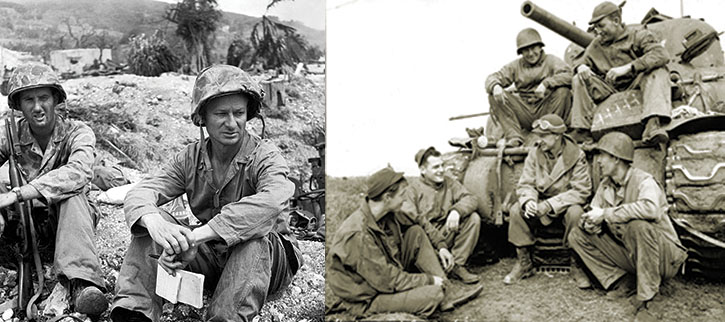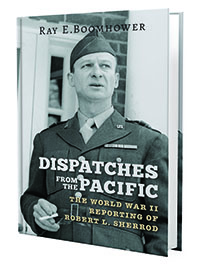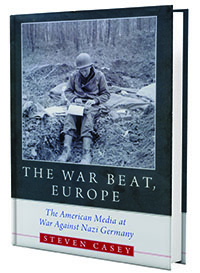
WINSTON CHURCHILL—an accomplished battlefield reporter long before he became a statesman—said the mission of a war correspondent is simple: it is to go “as far as you can as quickly as you can.” For Robert Sherrod, who covered some of the bloodiest battles of the war in the Pacific, that meant traveling more than 100,000 miles by plane and warship and landing with Marines on Tarawa, Saipan, Iwo Jima, and Okinawa.

the Pacific:
The World War II Reporting of Robert L. Sherrod
By Ray E. Boomhower.
260 pp. Indiana University Press, 2017. $24 (paperback).
His book on Tarawa, banged out only months after the campaign, remains a classic of frontline war reportage. But it was in his writings for Time and Life that Sherrod gave millions of Americans a clear, and sometimes gritty, picture of what the Marines were encountering as they fought their way across the Pacific. Biographer Ray E. Boomhower’s Dispatches from the Pacific: The World War II Reporting of Robert L. Sherrod is a compelling read about a reporter whose dedication, drive, and personal bravery brought the war home.
Sherrod, worried that the American public had become complacent about what it would take to beat the Japanese, was determined to produce a realistic portrayal of combat in the Pacific. He successfully achieved his goal using vivid prose, produced under dangerous and primitive conditions.
On a personal level, Sherrod was motivated by the same spirit that drove the Marines he had come to revere. “Sherrod proved willing to risk his life rather than to have the Marines believe he was one of the ‘communique commandos’ who wrote about combat from the safety behind the lines,” Boomhower writes. Growing fearful as he was about to climb on to a landing craft for Iwo Jima, Sherrod considered staying back on the ship but changed his mind when, the author explains, “he saw the faces of the Marines from the Fourth Marine Division he had been scheduled to land with—faces that had written on them ‘the same fear that gripped at my guts.’” Sherrod climbed into the landing craft.
In a time of celebrity journalists and endless opinionating, Dispatches from the Pacific is a useful reminder about the service good journalism provides and the sacrifices reporters like Sherrod made to produce it.
World War II correspondents wore uniforms, submitted their stories to censors, and depended on the military for transportation, food, and other necessities in the field. Sometimes they self-censored their own work, as when Sherrod uncovered a mutiny among African American troops against their white officers in Australia. The reporter said it was “one of the biggest stories of the war which can’t be written—and which shouldn’t be written, of course.” Sherrod and other reporters of his generation worried about the effect their stories would have on morale or support back home. More commonly, though, it was security concerns that kept stories out of the press. Sherrod was aboard ships during harrowing kamikaze attacks from enemy fighters, but navy censors banned any reporting on the new Japanese tactic for six months.

The American Media at War Against Nazi Germany
By Steven Casey. 448 pp. Oxford University Press, 2017. $34.95.
War reporters, however, were far from shills for the military, as Steven Casey makes clear in The War Beat, Europe: The American Media at War Against Germany. “These were not compliant cheerleaders who abandoned all thought of impartiality to trumpet the official line,” Casey concludes in this well-researched overview of reporters in Europe.
They fought censors when they thought the military was abusing its authority. They clashed with controlling public relations officers and preening generals. (Sitting for photos to accompany a Time magazine article, Lieutenant General George S. Patton had specific instructions for legendary photographer Margaret Bourke-White: “Don’t show my jowls.”)
The War Beat, Europe describes the competition, egos, and adrenaline that go into war reporting. The danger, too: 54 American reporters died while covering all theaters of the war. One of those was the revered Ernie Pyle. Even before his death—by a Japanese machine gun on Ie Shima Island near Okinawa on April 18, 1945—Pyle had grown weary of war and was showing signs of stress, but he forced himself back to the front. Millions of Americans eagerly awaited his syndicated columns.
But fame hadn’t changed the way Pyle reported his stories—by spending time with ordinary troops fighting America’s war. In that regard he was like many of his colleagues, who made enormous sacrifices and took risks to bring a true picture of the war to the American public. Judging by the quality of the journalism they produced, this crop of American reporters comes out with spectacularly high marks.
—Jim Michaels is a military reporter for USA Today and has covered wars in Iraq and Afghanistan. He is author of A Chance in Hell: The Men Who Triumphed Over Iraq’s Deadliest City and Turned the Tide of War (2010).
This review was originally published in the December 2017 issue of World War II magazine. Subscribe here.





